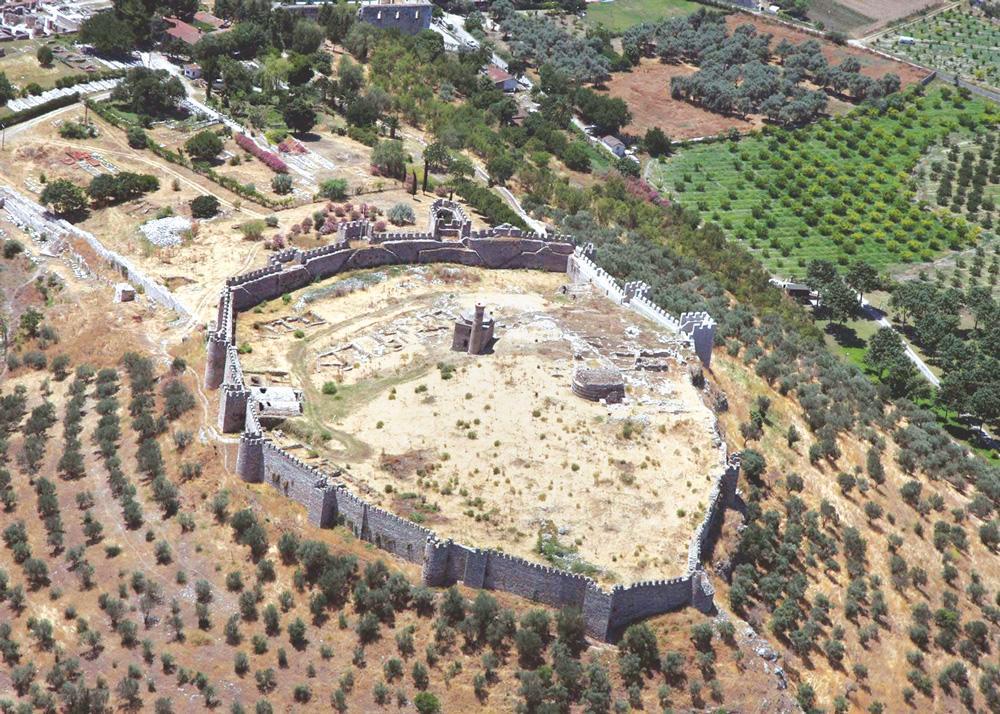Ayasuluk Castle, the crown of Selçuk, under restoration
ÖZGEN ACAR

St. John, who converted from Judaism to Christianity, is one of the 12 apostles of Jesus Christ. Three out of the four Bibles were written in Anatolia. According to some, St. John wrote one of them in Rumkale, while according to others, he wrote them in İzmir’s Selçuk district when he was 90. He died at the age of 100 there and was buried in Ayasuluk hill.

Later on, seven churches were built on behalf of him. All of them are in Anatolia. The most famous one is in Selçuk, where he is buried.
Every year nearly 1 million pilgrims visit this church, which is the second most visited place after the Ephesus, an important religious center for Christians.
As it is known, Virgin Mary was buried in Bülbül Mount, known as Panaya Kapulu by Christians, in Selçuk.
A simple mausoleum was built for St. John, buried in the southern slope of the Ayasuluk Hill, as well as a timber-roofed basilica from the 5th century.
When the basilica was damaged by earthquakes in the 6th century, Byzantine Emperor Justinian and his wife Theodora (527-565) built the new cross-planned and domed basilica.
The castle, located on top of the Ayasuluk Hill, is like the crown of Selçuk.
When the people of Ephesus moved to Ayasuluk in the 7th century, the basilica took place of former eparchy church.

When Turks captured Ephesus in 1304, the name and the capital of the Aydınoğulları Beylic became Ayasuluk after 1350. During this period, the İsabey Mosque, baths, tombs, madrasahs and hans were built.
The Ottomans took possession of Ayasuluk in 1430. The Bey Mansion, which was built by İsa Bey in the Aydınoğulları period in the castle, was used by Ottoman commanders. The structure, which is also known as Dizdar Mansion, served until the 1670s.
Excavations initiated by Austrian archaeologists in Ephesus and the Artemis Temple along with the İzmir-Aydın highway that came into service in 1860 revived the city. This is understood from the fact that English and Italian travelers were depicted in various Ayasuluk gravures.

A decision was made in 2015 to restore the Ayasuluk Hill and the Gate of Persecution, which is the main entrance of the St. John Church. Christians called the gate “persecution” as they believed the reliefs on the gate depict the persecution of the Romans to Christians.
However, the reliefs describe Achilles’ dragging of Hector after he killed him in the Trojan War.
The same scene is depicted on a sarcophagus found in Ephesus, which is on display at the Adana Museum.
A similar one to this sarcophagus was found in Tyre, Lebanon.

During the Greek occupation of İzmir between 1920 and 1922, Greek archaeologist G. A. Sotiou excavated the burial field of Sr. John and found it empty. But his relics were transferred to the Havariun Church in Istanbul in the 6th century.
The first excavation and restoration work in the gate was carried out by the Ephesus Museum Directorate in the 1960s. Some protective measures were taken in the 1980s around the walls of the arch of the gate. With a cabinet decision in 2007, the Ayasuluk Castle and the St. Jean excavations and restorations were included within the scope of the university excavations. In 2010 it was determined that the inner walls of the East Tower of the gate were hazardous.
The restoration of the Gate of Persecution was initiated in September 2017 under the leadership of Assistant Professor Mustafa Büyükkolancı of Pamukkale University.
Only the sarcophagus with Eros was left behind from the reliefs.
But the reliefs on the gate were taken to England in 1812. They are currently on display at the Woburn Abbey Art Gallery. Büyükkolancı still continues his efforts sending the laser scans of the reliefs for the gallery. If they get sent, his goal is to get the reconstruction of the reliefs on CNC machines and put them back in their place. Thus, this historical place will welcome its visitors in a better way.
In this regard, the embassy in London plays an important role, too.
















